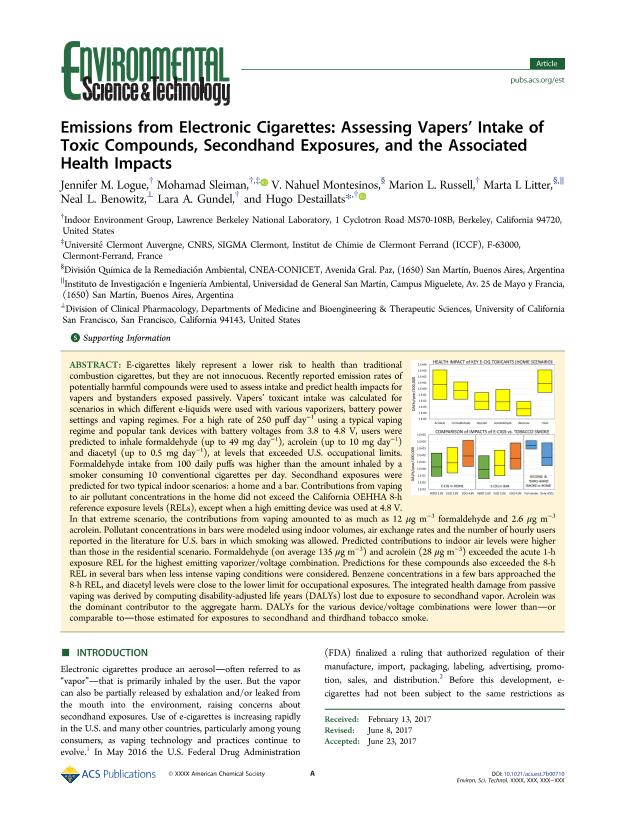Mostrar el registro sencillo del ítem
dc.contributor.author
Logue, Jennifer M.
dc.contributor.author
Sleiman, Mohamad
dc.contributor.author
Montesinos, Victor Nahuel

dc.contributor.author
Russell, Marion L.
dc.contributor.author
Litter, Marta Irene

dc.contributor.author
Benowitz, Neal L.
dc.contributor.author
Gundel, Lara A.
dc.contributor.author
Destaillats, Hugo

dc.date.available
2020-11-04T13:18:00Z
dc.date.issued
2017-08
dc.identifier.citation
Logue, Jennifer M.; Sleiman, Mohamad; Montesinos, Victor Nahuel; Russell, Marion L.; Litter, Marta Irene; et al.; Emissions from Electronic Cigarettes: Assessing Vapers’ Intake of Toxic Compounds, Secondhand Exposures, and the Associated Health Impacts; American Chemical Society; Environmental Science & Technology; 51; 16; 8-2017; 9271-9279
dc.identifier.issn
0013-936X
dc.identifier.uri
http://hdl.handle.net/11336/117569
dc.description.abstract
E-cigarettes likely represent a lower risk to health than traditional combustion cigarettes, but they are not innocuous. Recently reported emission rates of potentially harmful compounds were used to assess intake and predict health impacts for vapers and bystanders exposed passively. Vapers' toxicant intake was calculated for scenarios in which different e-liquids were used with various vaporizers, battery power settings and vaping regimes. For a high rate of 250 puff day-1 using a typical vaping regime and popular tank devices with battery voltages from 3.8 to 4.8 V, users were predicted to inhale formaldehyde (up to 49 mg day-1), acrolein (up to 10 mg day-1) and diacetyl (up to 0.5 mg day-1), at levels that exceeded U.S. occupational limits. Formaldehyde intake from 100 daily puffs was higher than the amount inhaled by a smoker consuming 10 conventional cigarettes per day. Secondhand exposures were predicted for two typical indoor scenarios: a home and a bar. Contributions from vaping to air pollutant concentrations in the home did not exceed the California OEHHA 8-h reference exposure levels (RELs), except when a high emitting device was used at 4.8 V. In that extreme scenario, the contributions from vaping amounted to as much as 12 μg m-3 formaldehyde and 2.6 μg m-3 acrolein. Pollutant concentrations in bars were modeled using indoor volumes, air exchange rates and the number of hourly users reported in the literature for U.S. bars in which smoking was allowed. Predicted contributions to indoor air levels were higher than those in the residential scenario. Formaldehyde (on average 135 μg m-3) and acrolein (28 μg m-3) exceeded the acute 1-h exposure REL for the highest emitting vaporizer/voltage combination. Predictions for these compounds also exceeded the 8-h REL in several bars when less intense vaping conditions were considered. Benzene concentrations in a few bars approached the 8-h REL, and diacetyl levels were close to the lower limit for occupational exposures. The integrated health damage from passive vaping was derived by computing disability-adjusted life years (DALYs) lost due to exposure to secondhand vapor. Acrolein was the dominant contributor to the aggregate harm. DALYs for the various device/voltage combinations were lower than - or comparable to - those estimated for exposures to secondhand and thirdhand tobacco smoke.
dc.format
application/pdf
dc.language.iso
eng
dc.publisher
American Chemical Society

dc.rights
info:eu-repo/semantics/openAccess
dc.rights.uri
https://creativecommons.org/licenses/by-nc-sa/2.5/ar/
dc.subject
e-cigs
dc.subject
DALYs
dc.subject
Acrolein
dc.subject.classification
Otras Ciencias Químicas

dc.subject.classification
Ciencias Químicas

dc.subject.classification
CIENCIAS NATURALES Y EXACTAS

dc.title
Emissions from Electronic Cigarettes: Assessing Vapers’ Intake of Toxic Compounds, Secondhand Exposures, and the Associated Health Impacts
dc.type
info:eu-repo/semantics/article
dc.type
info:ar-repo/semantics/artículo
dc.type
info:eu-repo/semantics/publishedVersion
dc.date.updated
2020-11-02T17:03:41Z
dc.journal.volume
51
dc.journal.number
16
dc.journal.pagination
9271-9279
dc.journal.pais
Estados Unidos

dc.journal.ciudad
Washington
dc.description.fil
Fil: Logue, Jennifer M.. Lawrence Berkeley National Laboratory. Environmental Energy Technologies División. Indoor Environment Group; Estados Unidos
dc.description.fil
Fil: Sleiman, Mohamad. Lawrence Berkeley National Laboratory. Environmental Energy Technologies División. Indoor Environment Group; Estados Unidos. Institut de Chimie de Clermont-ferrand; Francia
dc.description.fil
Fil: Montesinos, Victor Nahuel. Comisión Nacional de Energía Atómica. Gerencia del Área de Seguridad Nuclear y Ambiente. Gerencia de Química (CAC); Argentina. Consejo Nacional de Investigaciones Científicas y Técnicas; Argentina
dc.description.fil
Fil: Russell, Marion L.. Lawrence Berkeley National Laboratory. Environmental Energy Technologies División. Indoor Environment Group; Estados Unidos
dc.description.fil
Fil: Litter, Marta Irene. Universidad Nacional de San Martín. Instituto de Investigación en Ingeniería Ambiental; Argentina. Consejo Nacional de Investigaciones Científicas y Técnicas; Argentina. Comisión Nacional de Energía Atómica. Gerencia del Área de Seguridad Nuclear y Ambiente. Gerencia de Química (CAC); Argentina
dc.description.fil
Fil: Benowitz, Neal L.. University Of San Francisco.; Estados Unidos
dc.description.fil
Fil: Gundel, Lara A.. Lawrence Berkeley National Laboratory. Environmental Energy Technologies División. Indoor Environment Group; Estados Unidos
dc.description.fil
Fil: Destaillats, Hugo. Lawrence Berkeley National Laboratory. Environmental Energy Technologies División. Indoor Environment Group; Estados Unidos
dc.journal.title
Environmental Science & Technology

dc.relation.alternativeid
info:eu-repo/semantics/altIdentifier/url/http://pubs.acs.org/doi/abs/10.1021/acs.est.7b00710
dc.relation.alternativeid
info:eu-repo/semantics/altIdentifier/doi/http://dx.doi.org/10.1021/acs.est.7b00710
Archivos asociados
